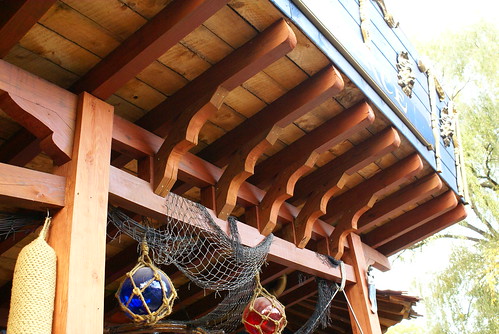Sixteen years ago, The Husband (at that time boyfriend of 10 years) and I were hired to oversee the construction of an entire Renaissance Festival. This 11 year old show had lost its lease, and was moving to a new piece of property 3 miles away. I was the Building Coordinator; probably the first ever in the history of permanent Renaissance parks.
I was 30 years old, and my job was to translate building code for the builders, some of whom had been building in these parks for almost 20 years without ever seeing a building inspector. I’d been working festival construction for 10 years, and drawing for permits in several different building code jurisdictions.
To say there was some friction would be an understatement. Renaissance festivals as a whole tend to be populated by open-minded people. However, these people also tend to be anarchists of a sort. They’ve made a living for themselves within an alternative community, and sometimes the rule-enforcers can be subject to a bit of push-back. I think more of it was due to my age than my sex. In truth, it was mostly that I was on the side of the regulations, and my job was to tell these guys when they were wrong, before the mistake was big enough to be spotted by the inspector that was onsite weekly.

When we were hired, the piece of land was completely unimproved. A group of folks who’d been doing festivals for years had designed a park with no inner circles, in an amoeba-like shape, with each arm anchored by a major stage. The early part of my job was leading what we called “Machete Tours” of the new site. While the old site was still in use, I escorted vendors on the new site, convincing them the move was a good investment, and helping them choose 3 different booth locations on which to build. The festival management wanted to maintain some flexibility in regards to building design compatibility and craft mix, so the final decision was made by a management committee. (I’m happy to say almost all got their 1st choice, and none had to resort to their 3rd choice.) At that time, this festival was open twice per year. This meant that vendors were designing shops that would access 8 weekends of sales in the spring, and 5 more in the fall. They turned in some truly lovely building designs.

The Husband (Phil) was hired as the builder of the festival’s structures. This would be the front gate, all of the stages, and a few other structures owned by the festival, such as the first aid/information building, and 2 major food areas. He didn’t actually have time to do any of these things. At the beginning of the project, we asked the Festival Management who the Job Supervisor was going to be. We hoped it was someone with some festival experience, and not simply a local person who owned a bulldozer. The answer to our question was a blank stare. When we were obviously growing nervous at this non-response, Management asked us, “What do you need a Job Supervisor to do other than what you two will be doing?” Phil started unfurling his fingers one at a time as he listed; “Someone has to lay out the park, decide where the road will be, decide on where the water, phone, and electricity providers will put in their respective utilities, lay out the parking lot, set elevations for individual buildings, set elevations for the grounds, design the campground …”. Just before Phil unfurled a tenth finger, he was made the Job Supe.
There is some discussion in the industry about whether or not it is beneficial to have building inspectors involved when trying to mimic a 400 year old village. (Refer back to the comment about Anarchists.) We are designing retail spaces that look like they belong in an English village in the 1600s. Levels and plumb-lines can make a structure look a bit “too crisp”. Builders voice concerns that inspectors drive up the cost of construction. The vendors that hire these builders hear that comment and agree … loathe to spend any more than necessary on the shops they build for only 20 days of sales or less per year. But building inspectors protect everyone. The Park and the Vendor are protected from the liability of a poorly designed building. The Vendor is protected from an unqualified builder, and the Guest is protected from injury. Qualified builders build to code anyway, so the price is consistent with or without a building inspector. I’d be leery of a builder who said he wouldn’t build on a site where he had to pull a permit.

In my experience, building inspectors are not arbitrarily difficult, although difficulties can arise from lack of familiarity with the unique buildings involved in a Renaissance Festival. With established parks, the city’s sales tax benefit usually ensures that the inspector wants the building to be able to open. In the best situations, inspectors visit throughout the building process, and coach through corrections in order to insure the design’s viability. Inspectors *will* hold the builder accountable to the permit-approved drawing; so there is no designing-on-the-fly other than trim and color variations. This is a small price to pay for the assurance that the building, and everyone associated with it are safe.
footnote: Much thanks to my friend Lars, who allowed me access to his portfolio at MidKnight Construction for the images used in this post.